
Advanced Features of Magento Product Recommendations
What if you could show the right product to the right customer every time? Magento product recommendations use AI and machine learning to deliver personalized shopping experiences.
The article explores the types, features, and top extensions of product recommendations.
Key Takeaways
-
Adobe Sensei uses AI to personalize shopping experiences.
-
Explore 13 powerful types of product recommendations.
-
Open Source and Adobe Commerce handle recommendations differently.
-
Headless and PWA support for modern storefronts.
-
Top Magento product recommendation extensions offers pros and cons.
What are Product Recommendations in Magento?
Adobe Sensei Intelligence
Advanced machine-learning engine analyzing customer behavior and product attributes in real-time
From trending products to visual similarity recommendations
Homepage, product pages, cart, and checkout optimization
Real-time behavioral analysis and visual similarity engine
Third-party solutions from LandOfCoder and Webkul
Key Enhancement Features
Product recommendations are AI tools designed to display personalized product suggestions to shoppers.
These recommendations use Adobe Sensei, an advanced machine-learning engine. It helps analyze customer behavior and product attributes in real time.
You can place them on:
-
Product pages
-
Category pages
-
Homepage
-
Shopping cart
The setup is simple via the Magento admin panel and requires no coding skills. It helps enhance user engagement and boost conversions.
The technique delivers relevant suggestions. It helps increase average order value and simplifies merchandising efforts.
These tools also provide analytics to track performance and optimize marketing strategies. It makes them a powerful feature for ecommerce growth.
13 Types of Product Recommendations in Magento
1. Related Products
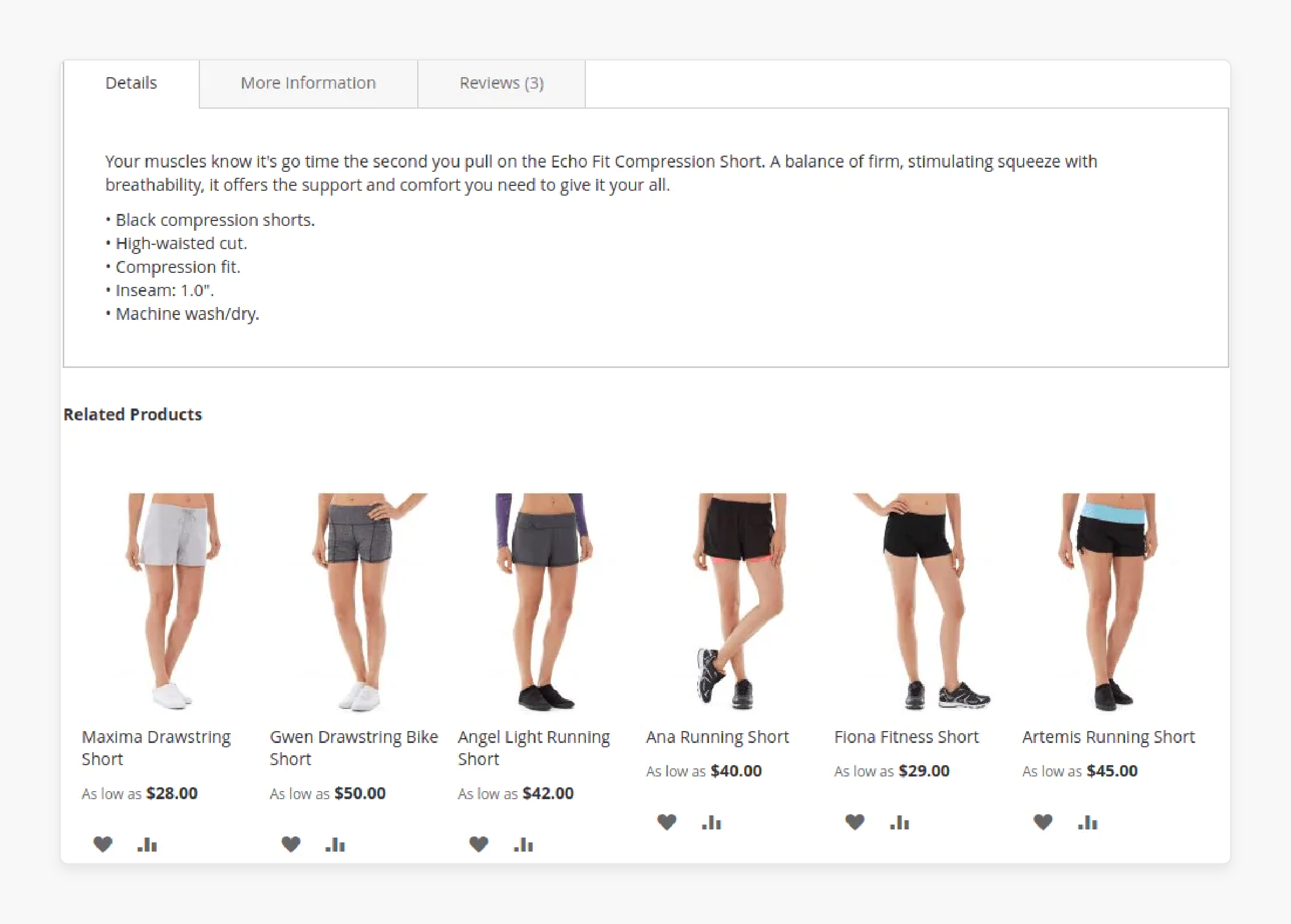
-
The recommended items are like or complement the product you are currently viewing.
-
For example, if a shopper is looking at a smartphone. Related products might include cases or chargers.
-
You can place them on product detail pages. It encourages customers to add more to their cart. It is by suggesting relevant add-ons or variations.
2. Upsells
-
Upsells present premium alternatives to the product you are viewing.
-
These are more expensive or feature-rich versions. These help upgrade the customer's buy.
-
For example, showing a newer or higher-tier laptop model on a mid-range product page.
-
You can place them on product pages before the “Add to Cart” button. It helps increase the average order value.
3. Cross-sells
-
These are complementary products displayed on the shopping cart page. It helps encourage customers to add more items before checkout.
-
For example, recommending headphones or a mouse when a laptop is in the cart.
-
You can place them on the cart page. It helps boost order value through relevant add-ons.
4. Customers Who Viewed This Also Viewed
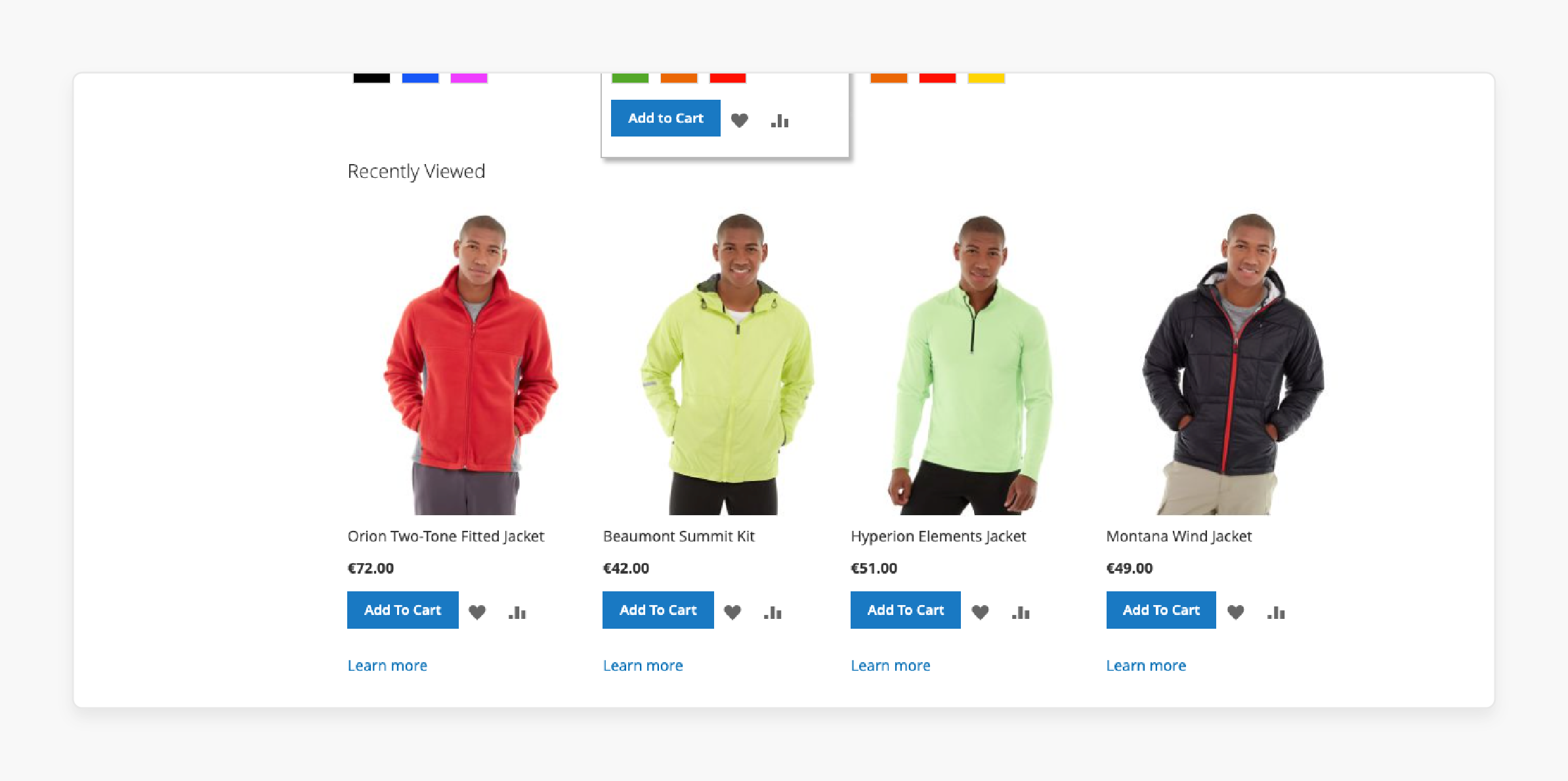
-
The recommendation depends on aggregated browsing behavior from other shoppers. It highlights products often viewed together.
-
For example, if many users who viewed Product A also looked at Product B, the system links both.
-
You can place them on product detail pages. It helps customers discover alternatives or explore popular items.
5. Recommended for You
-
It is a personalized recommendation type. It uses Adobe Sensei AI to analyze an individual shopper's activity. These include clicks and past purchases. It suggests products tailored to their interests.
-
You can place them on the homepage or category pages. It helps enhance personalization and boost engagement.
6. Trending Products
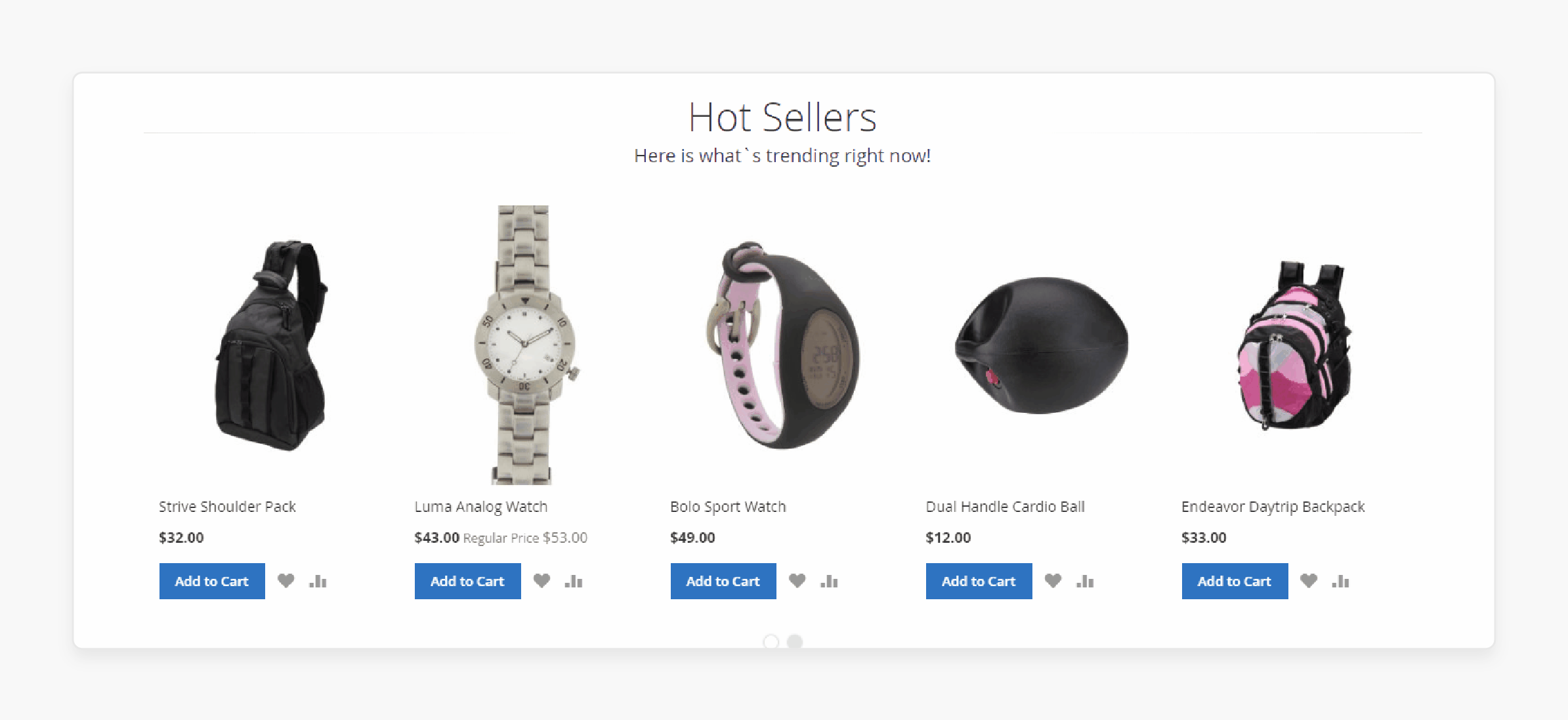
-
It displays popular products. It depends on real-time data, such as purchases and interactions across the site.
-
The system updates them to reflect what is currently in demand. You can place them on the homepage and category pages. It helps create urgency and align with current trends.
7. Bought This, Bought That
-
It shows products that are often bought together based on historical sales data.
-
For example, if customers who buy a coffee machine often buy specific coffee pods. The system recommends these pods.
-
You can place them on product pages and the cart. It facilitates product bundling and increases cart size.
8. Visual Similarity Recommendations
-
The recommendation uses AI to analyze visual attributes like color or style. They then recommend products that look like the one you are viewing.
-
For example, in fashion or home décor, similar-looking items offer alternatives.
-
You can place them on product pages. It helps improve product discovery, especially when aesthetics matter.
9. Recently Viewed Products
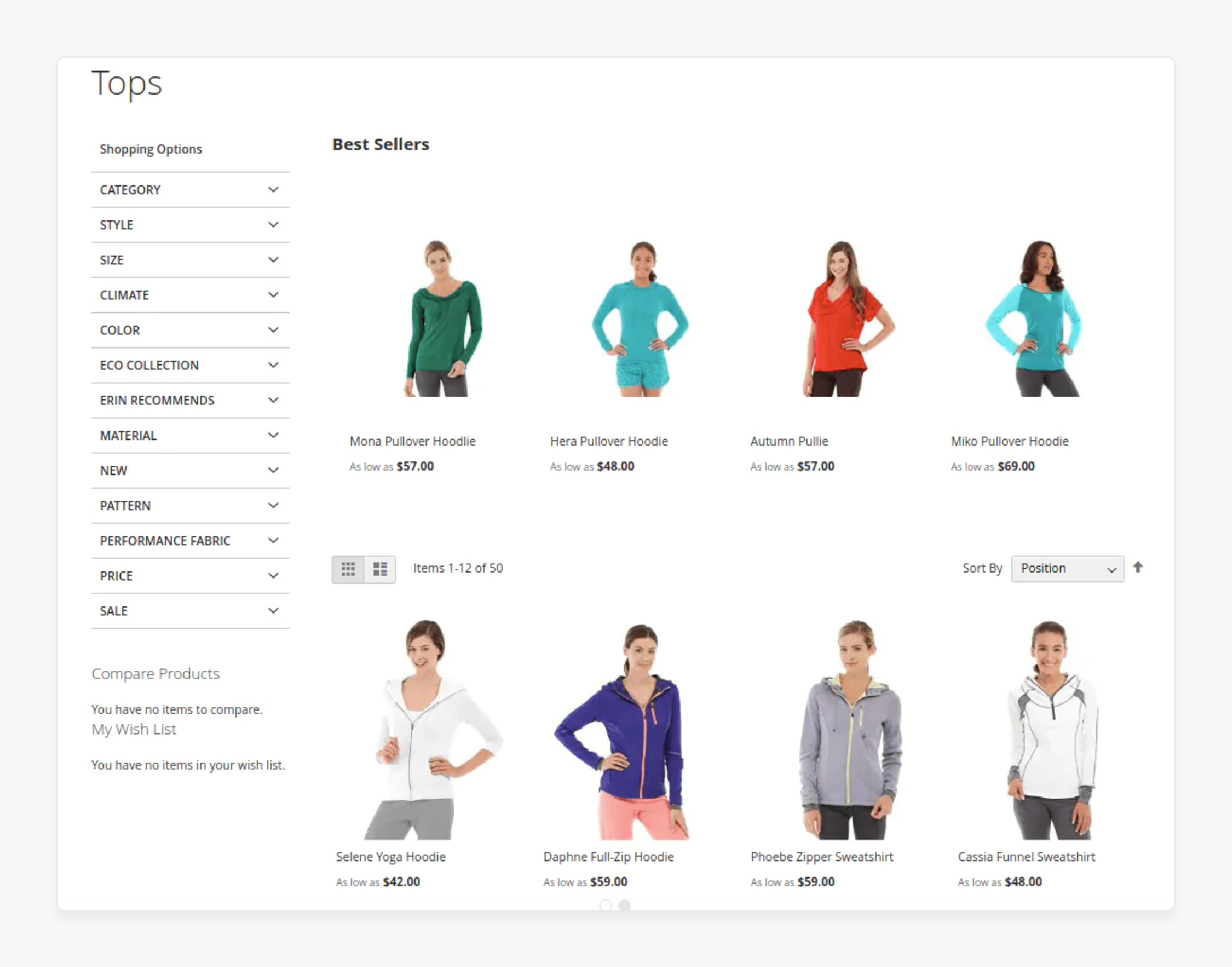
-
The recommended items show the customer items they recently looked at.
-
For example, customers see their recent views of running shoes and hydration belts.
-
You can place them on sidebars or dedicated “Recently Viewed” blocks. It helps users return to products they are considering. It helps improve navigation and conversions.
10. Most Viewed Products
-
The recommended items display items with the highest number of views store-wide.
-
For example, a “Hot Right Now” section shows the top 10 viewed laptops.
-
You can place them on homepage or popular products section. It showcases in-demand items and improves trust. It also helps boost engagement with newer visitors.
11. Recently Purchased Products
-
It highlights the user’s previous purchases or what others have recently bought.
-
For example, a user who bought protein powder sees shaker bottles or BCAA supplements.
-
You can place them on account page and post-purchase emails. It encourages repeat purchases and builds familiarity with known items.
12. New Arrivals
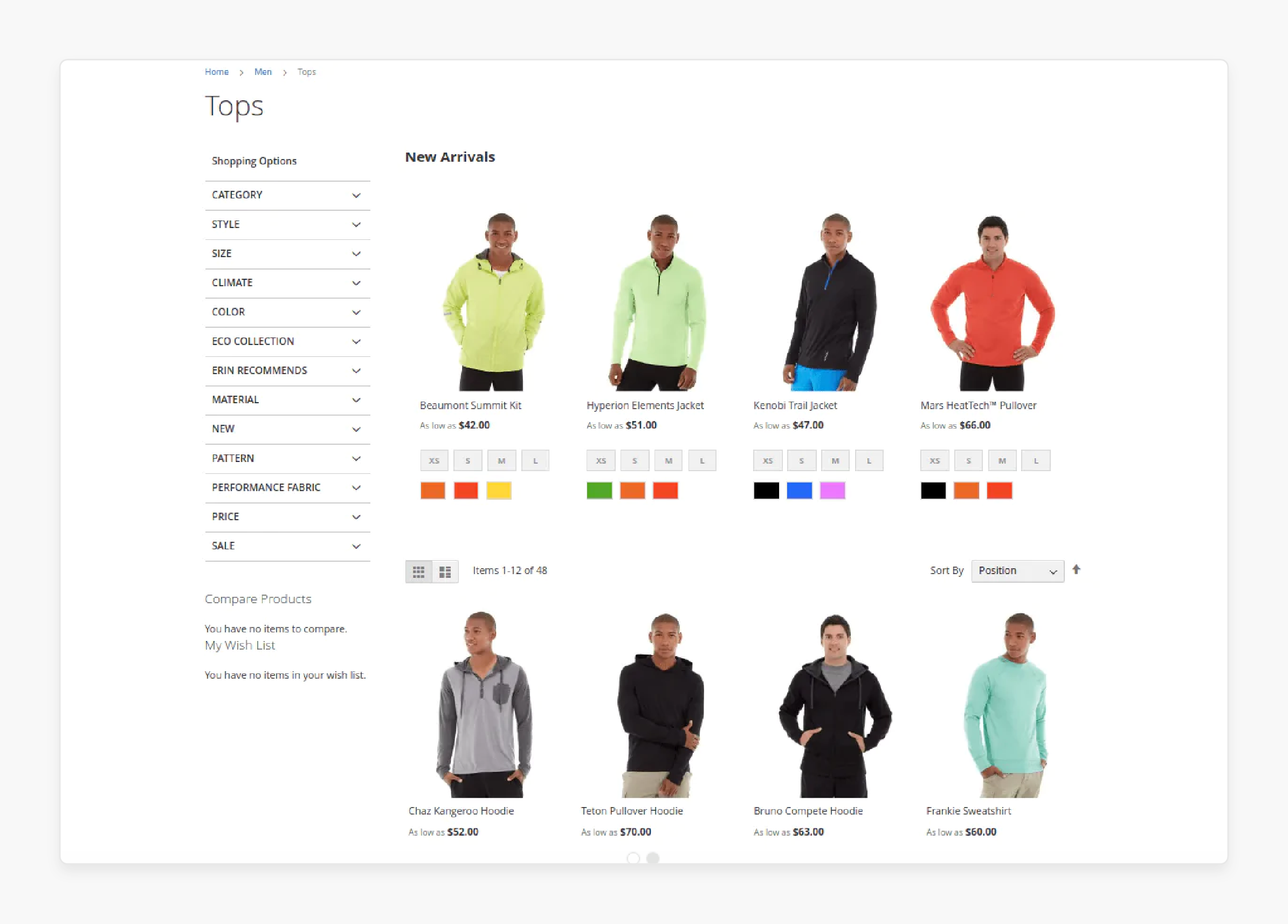
-
It features the latest products added to the store catalog.
-
For example, showing the latest spring fashion collection as soon as it goes live.
-
You can place them on category pages or dedicated “New In” sections. It encourages exploration and appeals to returning users looking for something fresh.
13. Top-Rated Products
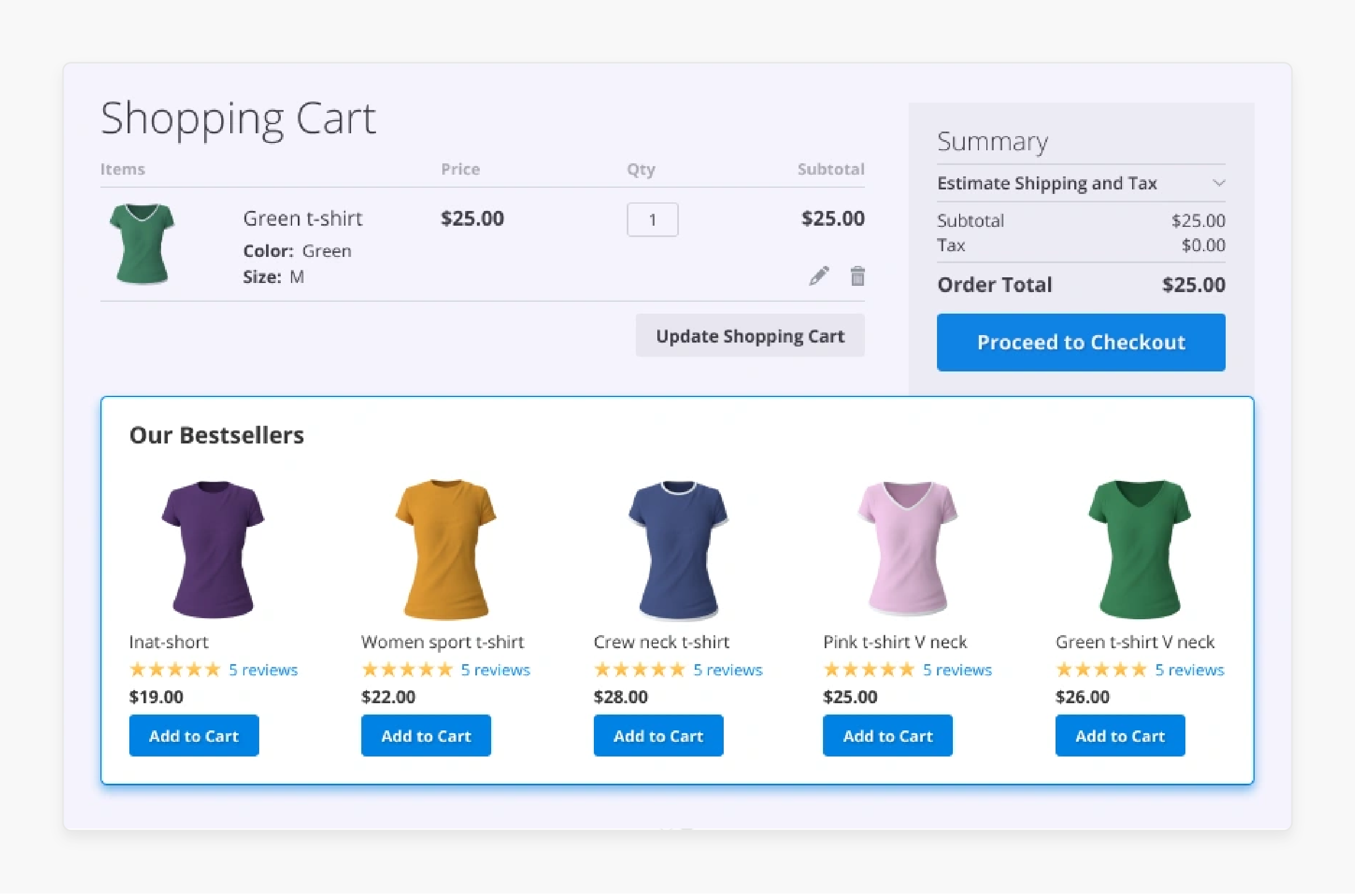
-
The recommendation include products with the highest customer ratings and reviews.
-
For example, featuring 4.8+ star rated skincare items in a “Customer Favorites” carousel.
-
You can place them on category pages or dedicated “Top Rated” sections. It increases buyer confidence by leveraging user feedback.
Interactive Recommendation Matrix
Explore placement strategies and features for each recommendation type
Related Products
Complementary items that enhance the current product
Upsells
Premium alternatives to increase average order value
Cross-sells
Complementary products displayed on cart page
Also Viewed
Based on aggregated browsing behavior patterns
Recommended for You
Personalized using Adobe Sensei AI analysis
Trending Products
Popular products based on real-time data
Bought Together
Products often purchased together
Visual Similarity
AI analysis of visual attributes and style
Recently Viewed
Items customer recently looked at
Most Viewed
Highest number of views store-wide
Recently Purchased
Previous purchases and related items
New Arrivals
Latest products added to store catalog
Top-Rated
Highest customer ratings and reviews
Recommendation Overview
3 Native Product Recommendation Features in Magento
1. Magento Open Source Capabilities
Magento Open Source provides basic product recommendation tools. The key features include:
-
Manual configuration by the merchants of:
1. Related products
2. Upsells
3. Cross-sells
-
You can place the recommendations on:
1. Product pages
2. Shopping cart pages
-
Some automation is possible using product rules or attributes to relate items.
Limitations:
-
It needs a manual setup for each product, making it inefficient for large catalogs.
-
It lacks advanced personalization and behavior-driven insights.
-
It also lacks the capability to recommend items based on images or aesthetics.
It is ideal for merchants with small catalogs or limited technical resources.
2. Adobe Commerce Capabilities
Adobe Commerce uses Adobe Sensei, an AI engine, to deliver smart product recommendations. The key features include:
-
AI recommendations based on real-time shopper behavior and trends. These include browsing patterns and product interactions.
-
Merchants can choose from over 13 recommendation types, including:
1. Trending Products
2. Most Viewed
3. Customers Who Bought This Also Bought
4. Visual Similarity
5. Recently Viewed or Purchased
6. Recommended for You
-
Comprehensive admin dashboard:
1. View performance metrics, including clicks and conversion rates
2. Optimize recommendations based on analytics
3. A/B test recommendation strategies
-
Uses a visual similarity engine to analyze product images and recommend similar items. It recommends products based on image analysis, not only metadata. It is useful in home decor and lifestyle products.
Technical Notes:
-
Deployed as a SaaS solution via Adobe’s cloud infrastructure
-
No need for merchants to manage AI models or data processing
-
Benefits from automatic updates, scalability, and enhanced security
It is ideal for mid-to-large enterprises looking to scale with data-driven personalization.
3. Headless and PWA Support
Both Open Source and Adobe Commerce support product recommendations in modern frontend architectures. The key features include:
-
REST or GraphQL APIs deliver product recommendations. It makes them usable in custom frontends built with React or Vue.
-
Smooth integration into mobile-optimized PWAs ensures users receive personalized recommendations. Whether they are shopping on a phone or a desktop.
-
Preserve recommendations across various channels. These include desktop sites and kiosks. It ensures continuity in the customer journey.
Top 2 Magento Product Recommendations Extensions
1. Magento 2 Product Recommendations Step - LandOfCoder
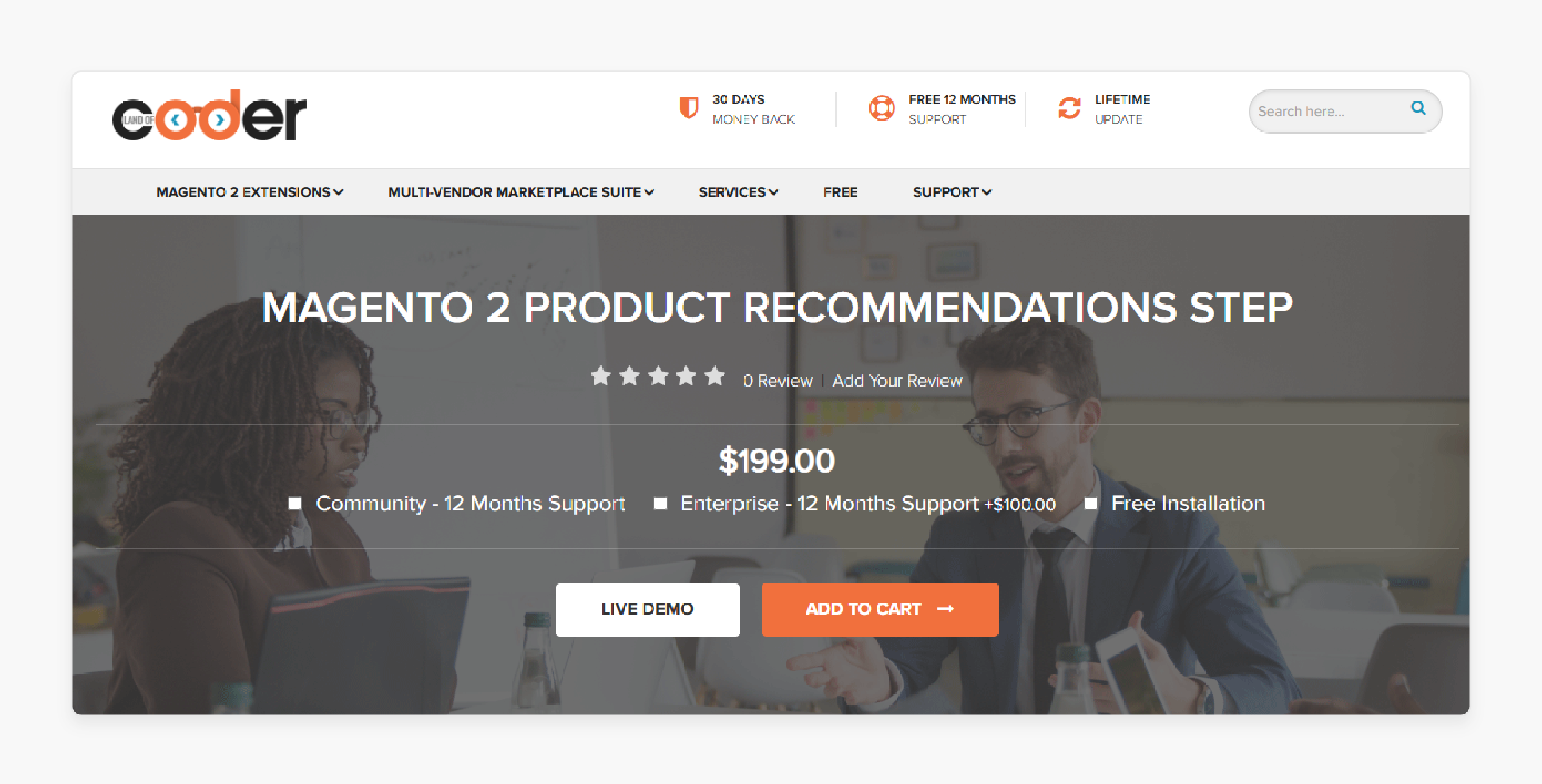
LandOfCoder’s product recommendations extension allows store admins to create questions and answers. These questions and answers have customer-oriented options. They then recommend that customers buy the best-fit item. With filter options, customers can reach recommended products. It is compatible with Magento 2.3.x and 2.4.x.
Key Features:
-
Use Ajax submit filter options & get products to display
-
Display filter form on the frontend by block & widget
-
Recommend category item as a result
-
Input product sku or category ID
-
Edit a specific combine rule
-
Manage & sort out questions with ease
-
Import & export recommendation rules via CSV
-
Manage and combine rules in the grid
-
Ready to use the REST API
-
Enable/ disable recommendations in the settings
Price: $199 (12 months)
2. Magento 2 AI Product Recommendation Extension - Webkul
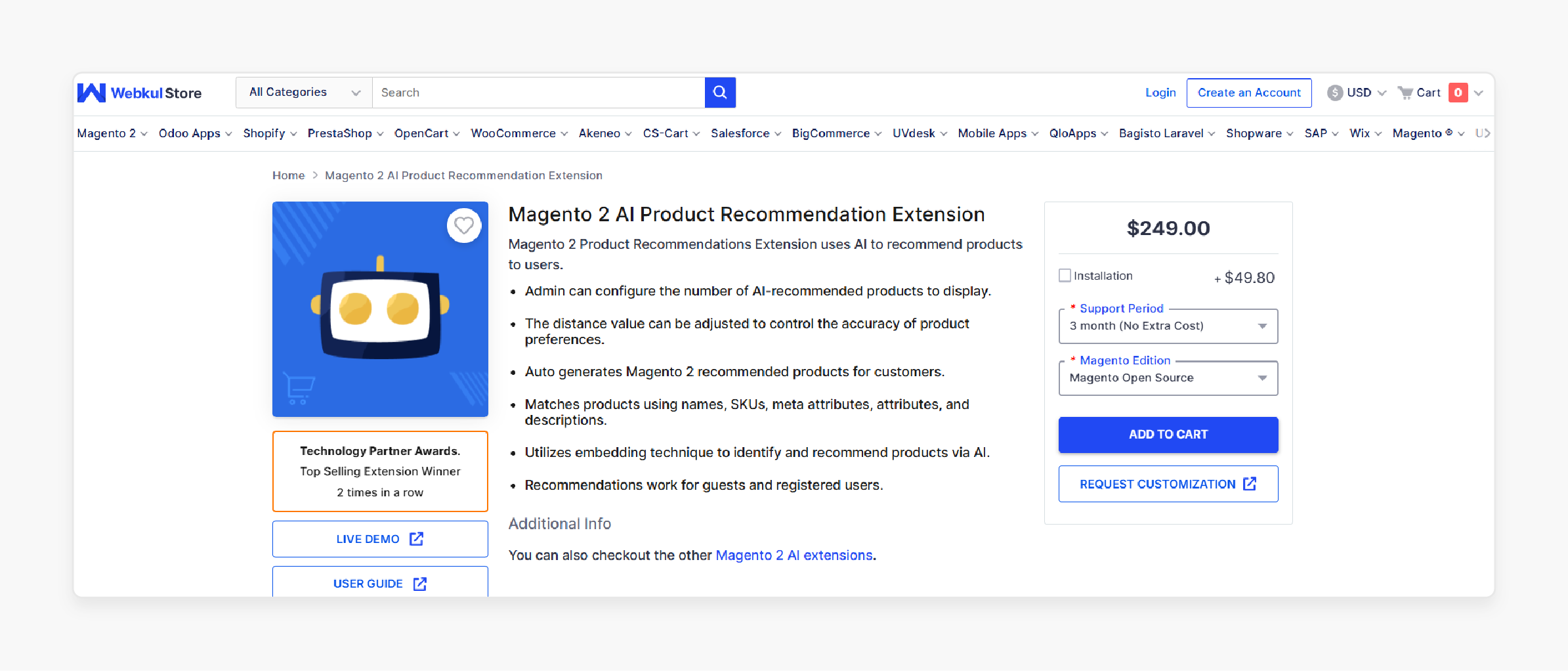
Webkul’s product recommendations extension uses AI to recommend products. It is compatible with Magento 2.0.x, 2.1.x, 2.2.x, 2.3.x, and 2.4.x.
Key Features:
-
Admin can configure the number of AI-recommended products to display.
-
You can adjust the distance value to control the accuracy of product preferences.
-
Auto-generates Magento 2 recommended products for customers.
-
Matches products using SKUs and meta attributes.
-
Uses an embedding technique to identify and recommend products via AI.
-
Recommendations work for guests and registered users.
Price:
-
Magento Open Source Edition: $249 (12 months)
-
Magento Adobe Commerce Edition: $747 (12 months)
Magento Recommended Products Extension vs AI-based Product Recommendations
| Feature | Magento Recommended Products Extensions | AI-Based Product Recommendation Platforms |
|---|---|---|
| 1. Recommendation Logic | It uses rule-based logic or attribute/tag matching. It might also use manual association. | It uses machine learning models trained on behavioral data. It might also use collaborative filtering and content-based filtering. |
| 2. Setup & Configuration | It is either manual or semi-automated. | AI training models automate it. |
| 3. Personalization | It offers the same recommendations to every shopper. There is no user segmentation or real-time context awareness. | It generates personalized recommendations for each visitor. It accounts for individual browsing history and time of day. It delivers 1:1 experiences across all sessions and channels. |
| 4. Visual Similarity | It is not supported in most extensions. | Platforms with computer vision support it. These include Adobe Sensei. |
| 5. A/B Testing & Optimization | It rarely includes built-in A/B testing. It offers manual tracking via third-party analytics. | It offers built-in A/B testing capabilities. It offers real-time analytics dashboards to track CTR and revenue impact. It allows marketers to test different strategies and algorithms. |
| 6. Integration Complexity | Installation is easy via the Magento Marketplace. It offers limited vendor support. Maintenance and updates depend on the extension provider. | It requires API or SDK integration. Dedicated customer success teams support it. The platform provider handles auto-scaling and feature rollouts. |
| 7. Cost | There is a low upfront cost. The one-time or subscription model costs less than $500. | It is subscription-based, with higher ongoing costs based on usage or revenue. |
| 8. Headless & PWA Support | It is often designed for traditional Magento frontends. It offers limited or no support for headless APIs or custom storefronts. | Full support with APIs and SDKs. It is compatible with headless Magento setups and Progressive Web Apps. It delivers a consistent experience across the web and in the app. |
| 9. Data Privacy & Hosting | Magento merchant-controlled server stores the data. | It offers cloud-based services. It could involve third-party data processing, depending on the platform. |
| 10. Maintenance | It offers vendor-specific support. It requires manual updates and troubleshooting. | It offers vendor-managed and dedicated customer success teams. |
Interactive Feature Comparison
Compare traditional extensions with AI-powered recommendation platforms
Decision Framework
Choose Extensions When:
- • Small to medium catalog size
- • Budget under $1,000/year
- • Traditional Magento frontend
- • Simple recommendation needs
Choose AI Platforms When:
- • Large product catalog
- • High traffic volume
- • Headless or PWA architecture
- • Advanced personalization requirements
Optimizing Product Recommendations for the Most Impact
1. Strategic Placement Across the Customer Journey
Effective product recommendations depend on where they appear in the customer journey. Tailoring placement ensures they feel helpful rather than disruptive:
-
The homepage highlights bestsellers or personalized “Recommended for you” items to engage visitors.
-
Category pages suggest similar items within the category or complementary products. It helps users explore more options.
-
Product pages feature related products or “Customers who viewed this also viewed” sections. It helps deepen product discovery.
-
The cart page offers cross-sell items that complement what is already in the cart. There is no distraction.
-
Checkout presents low-friction add-ons to boost AOV without interrupting the buying process.
-
Post-purchase, show complementary products in order confirmation emails or account pages.
Customer Journey Optimization
Strategic placement across the customer journey for maximum impact
Homepage Entry
Engage visitors immediately with bestsellers and personalized recommendations
Category Exploration
Help customers explore within categories and discover complementary products
Product Detail Pages
Deepen product discovery and increase average order value through targeted suggestions
Cart & Checkout
Final opportunity to increase order value with strategic add-ons and accessories
Post-Purchase Engagement
Build customer loyalty and encourage repeat purchases through targeted follow-up
Journey Optimization Impact
2. A/B Testing Strategies
Continuous testing ensures your recommendations evolve based on data, not assumptions:
-
Test recommendation types, such as related upsells and cross-sells, on the same page.
-
Experiment with placement positions, such as above-the-fold vs. below-the-fold.
-
Compare headings like “You may also like” versus “Often bought together.” It helps you see which drives higher engagement.
-
Test the number of items shown in a carousel versus static displays. It will help you find the ideal balance between choice and clarity.
Modern platforms like Adobe Commerce and third-party tools offer A/B testing. It helps measure and iterate.
Strategy Testing Platform
Compare recommendation strategies with real-time A/B testing results
Test Configuration
Strategy A
Strategy B
Test Settings
Related Products
Upsells
Winner: Strategy B - Upsells
Implement upsells on product pages for 28% revenue increase with 92% confidence.
A/B Testing Best Practices
Test Setup Guidelines:
- • Test one variable at a time
- • Run tests for minimum 1-2 weeks
- • Ensure adequate sample size
- • Account for seasonal variations
- • Test during typical traffic patterns
Statistical Validity:
- • Aim for 95% statistical significance
- • Consider practical significance
- • Monitor multiple success metrics
- • Validate results with follow-up tests
- • Document learnings for future tests
3. Rule-Based vs. AI-Powered Recommendations
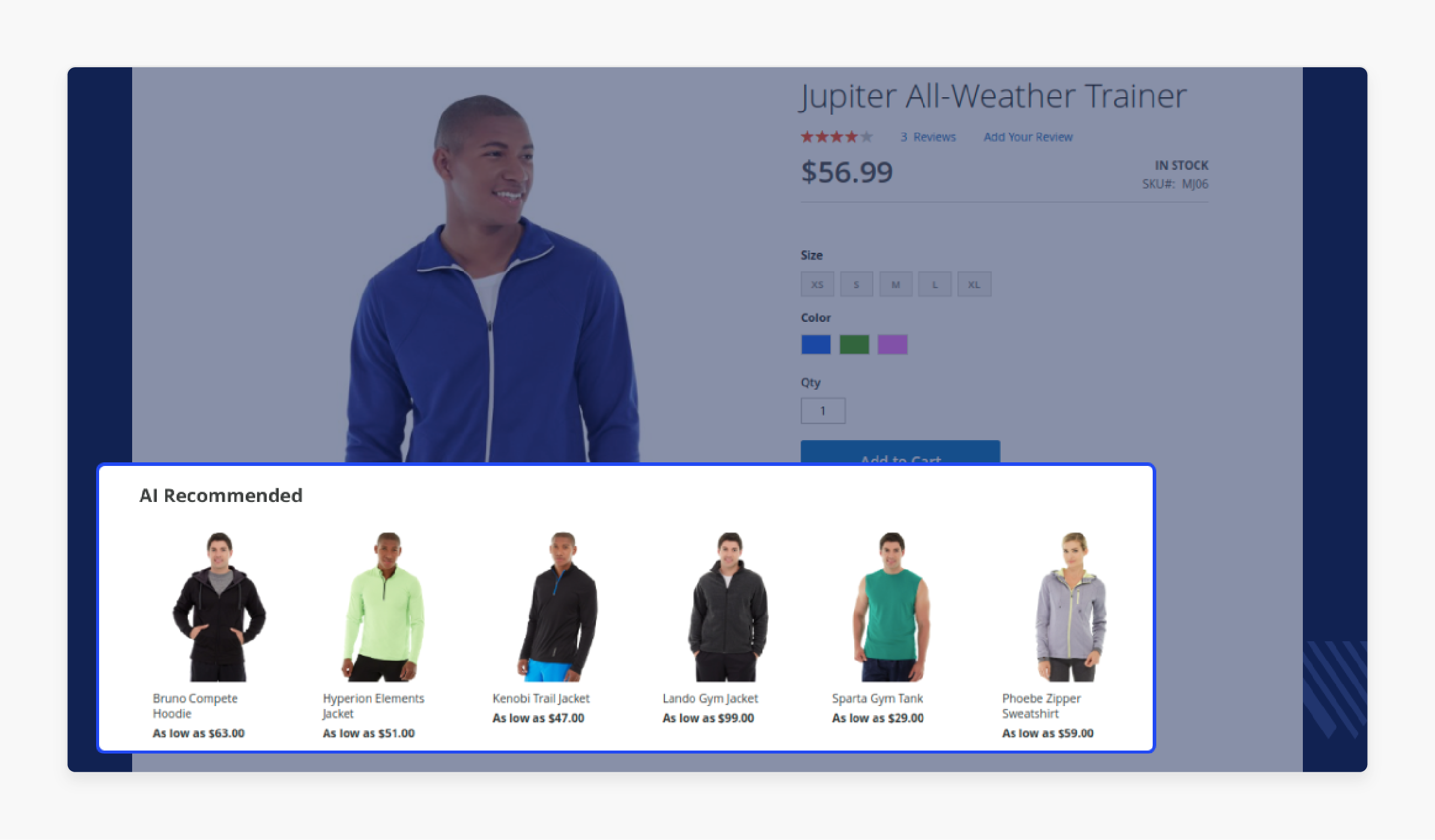
Choosing the right recommendation engine depends on business needs and data availability:
-
Rule-based recommendations are ideal for:
1. New or low-traffic stores lacking behavioral data
2. Promotions requiring control over featured products
3. Merchandising strategies focused on high-margin or seasonal items
-
AI-Powered recommendations are best suited for:
1. Personalized experiences based on real-time user behavior
2. Surfacing non-obvious relationships between products
3. Adapting to changing customer preferences
Many merchants enjoy a hybrid approach. They use rules for campaign-driven placements and AI for ongoing, behavior-based personalization.
4. Segmentation and Personalization Strategies
Personalized recommendations are most effective when aligned with customer segmentation. Consider these approaches:
-
Group users by browsing habits or cart activity. Customize according to your location or language preferences.
-
New visitors show bestsellers or trending items. We recommend returning users based on items they have viewed or abandoned. Loyal customers suggest replenishment or exclusive offers.
-
Adapt recommendations based on current session behavior or entry source.
-
Login users can use buying history and preference data. It helps tailor the entire shopping experience.
Tools like Adobe Sensei or Nosto enable dynamic segmentation and real-time personalization.
FAQs
1. How do I set up product recommendations in Magento Open Source?
In Magento Open Source, access product editing. Navigate to the "Related Products, Up-Sells, and Cross-Sells" tab and select products. It requires configuration for each product.
2. What is the difference between related products, upsells, and cross-sells?
Related products are similar or complementary items shown on product pages. Upsells are premium alternatives to the current product. Cross-sells are complementary products displayed on the shopping cart page.
3. How do AI-powered recommendations work in Adobe Commerce?
AI-powered recommendations in Adobe Commerce use Adobe Sensei. It helps analyze customer behavior data and identify patterns. It predicts which products individual shoppers are most likely to buy. It helps deliver personalized suggestions in real-time.
4. How can I measure the ROI of my product recommendations?
Recommendation Performance Analytics
Track CTR, conversion rates, and revenue attribution for recommendations
Performance by Recommendation Type
ROI Investment Calculator
Measurement Best Practices
Track These Metrics:
- • Click-through rates for each type
- • Conversion rates from clicks
- • Revenue attributed to recommendations
- • Average order value impact
- • Customer lifetime value changes
Optimization Tips:
- • A/B test recommendation placement
- • Review performance monthly
- • Adjust based on seasonal trends
- • Test different recommendation counts
- • Monitor for recommendation fatigue
Measure ROI by tracking CTR on recommendations and conversion rates from those clicks. Also, track revenue attributed to recommendation-driven purchases. Compare these metrics against implementation and ongoing costs.
5. How often should I update my product recommendation strategy?
Review recommendation performance monthly, making minor adjustments based on data. Conduct a comprehensive strategy review quarterly. Also, when making significant changes to your catalog or customer experience.
Summary
Magento product recommendations enhance ecommerce performance by delivering personalized suggestions. The article explores the features of the technique, including:
-
Offers 8 AI-driven recommendation types, including upsells and visual similarity.
-
Adobe Commerce provides advanced features and A/B testing via Adobe Sensei.
-
Magento Open Source supports basic, rule-based recommendations suitable for small stores.
-
Extensions and AI platforms vary in personalization depth, setup ease, and cost.
Boost your store’s performance with smart product recommendations. Choose managed Magento hosting for smooth integration and faster delivery.

